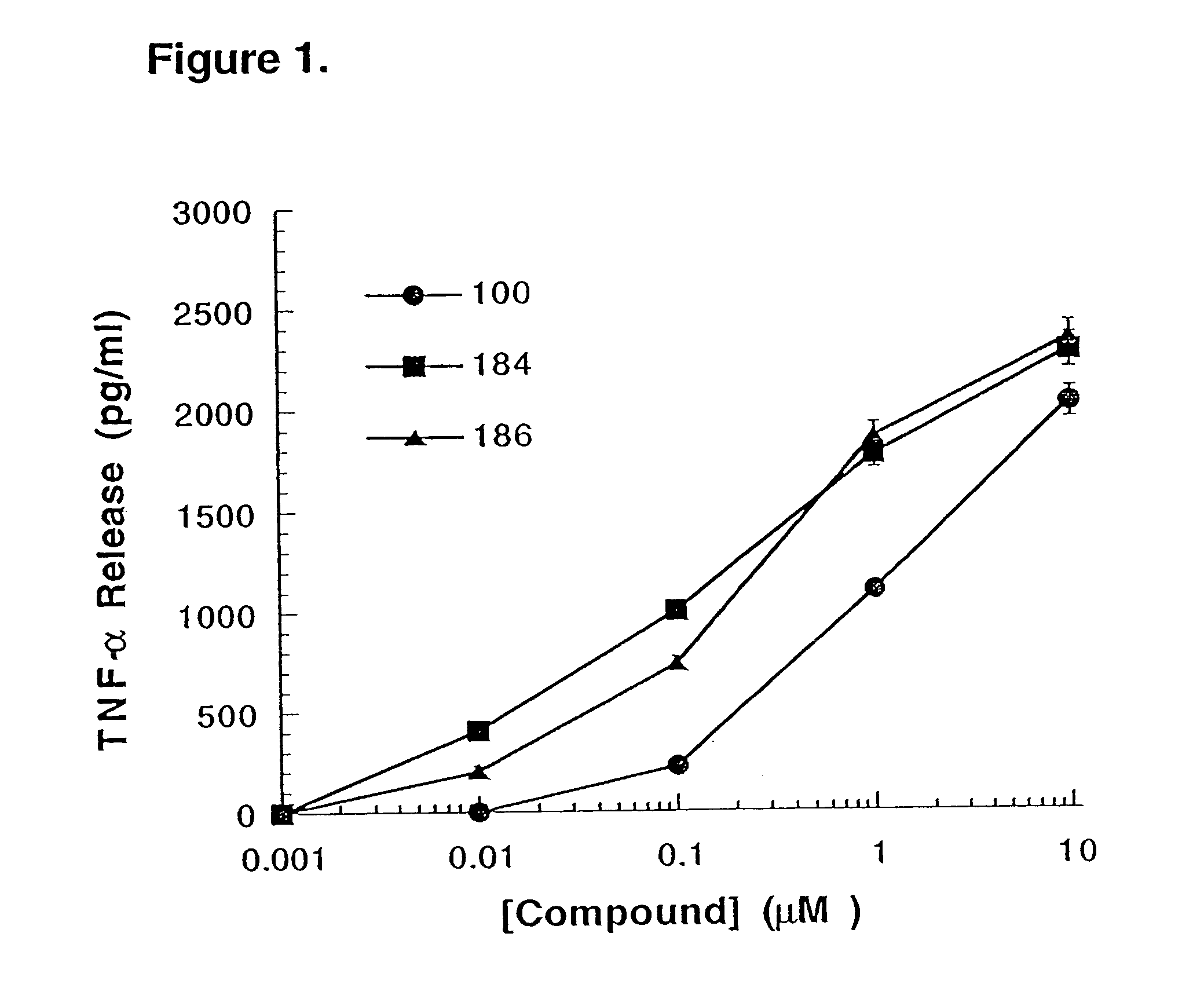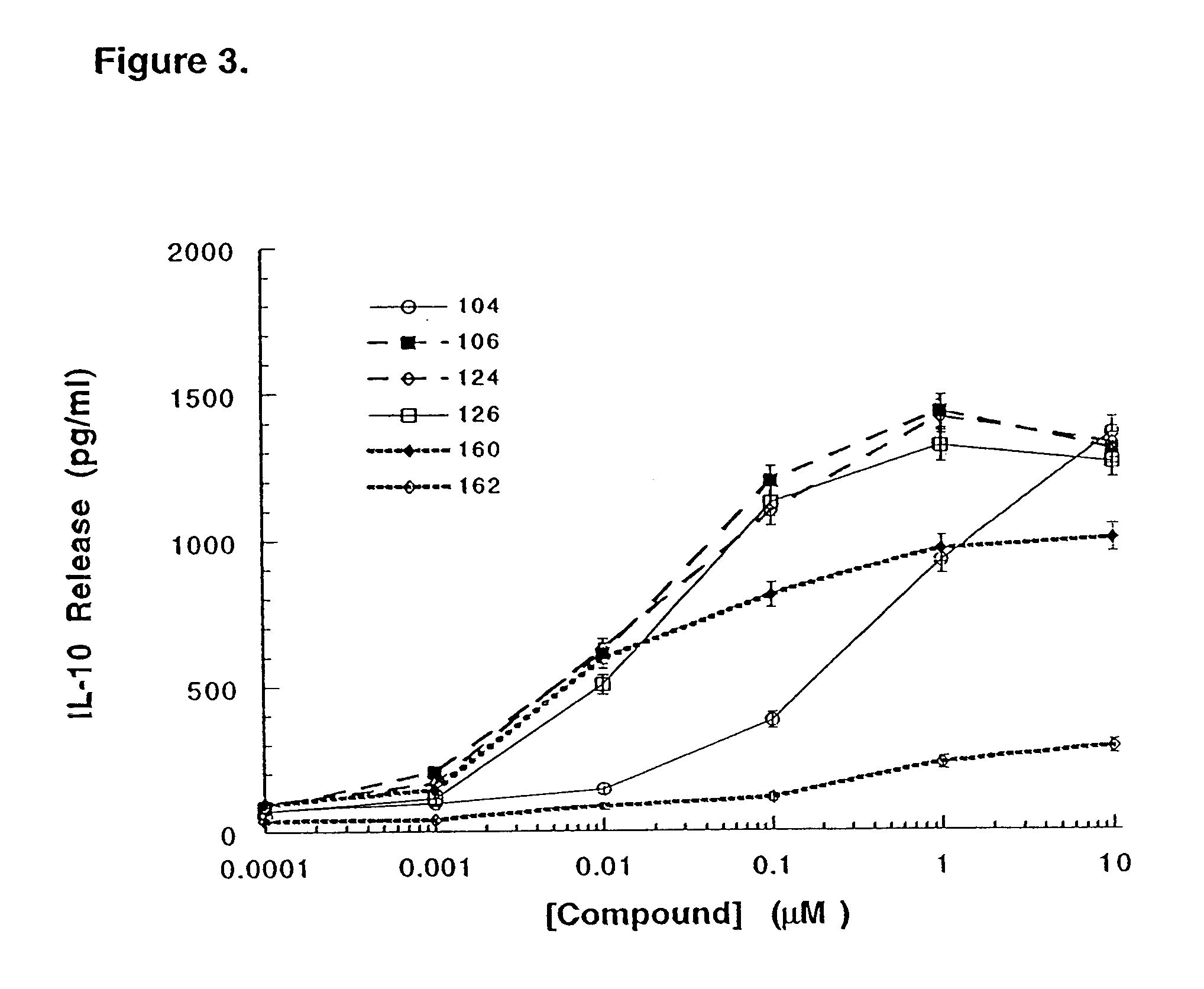Immunomodulatory compounds and methods of use thereof
a technology of immunomodulatory compounds and compounds, applied in the field of immunomodulatory compounds, can solve the problems of inability to use freund's adjuvant in humans, inability to elicit a sufficient antibody response to confer immunity, and inability to elicit sufficient antibody respons
- Summary
- Abstract
- Description
- Claims
- Application Information
AI Technical Summary
Problems solved by technology
Method used
Image
Examples
example 1
Succinate-1
[0097]
[0098]To a solution of sodium azide (107.67 g) in 250 mL of water was added 300 mL of methylene chloride. The mixture was cooled to 0° C. and trifluoromethanesulfonic anhydride (57 mL) was added dropwise at a 0.32 mL / minute rate. The mixture was stirred for an additional 6 hours at 0° C. and stored at −20° C. for 72 hours. The mixture was warmed to 10° C. followed by extraction with methylene chloride in a Teflon® separatory funnel. The combined organic layers were dried (magnesium sulfate). The above suspension was slowly filtered into a stirred solution of (±)-2-amino-1,3-dihydroxypropane (1) (9.89 g) in methanol (200 mL) and 4-N,N-dimethylaminopyridine (DMAP, 54 g) at 10° C. The resultant reaction mixture was stirred for 17 hours at room temperature.
[0099]The solvent was removed under reduced pressure and the residue dissolved in pyridine (200 mL) and cooled to 0° C. Acetic anhydride (50 mL) was added dropwise and the mixture stirred for 20 hours at room temperat...
example 2
Chiral Malonate-Type 1
[0124]
[0125]To a cooled solution of potassium carbonate (165 g) in water (575 mL) was added methylene chloride (200 mL) followed by ethyl benzimidate hydrochloride (17) (100 g) after which time the mixture was stirred for 8 minutes. The layers were separated and the aqueous layer extracted with methylene chloride. The organic layers were combined, dried and the solvent removed under reduced pressure to give 83 g of (18).
[0126]
[0127]To a solution of L-serine methyl ester hydrochloride (19) (41.6 g) in 1,2-dichloroethane (450 mL) was added ethyl benzimidate (18) (36 g). The mixture was heated to reflux for 20 hours, cooled, filtered through diatomaceous earth, and concentrated to dryness to give 56 g of ethyl ester (21) as a white solid.
[0128]
[0129]To an ice cold solution of ethyl ester (21) (56 g) in THF (500 mL) was added dropwise diisobutylaluminum hydride (DIBAL, 545 mL of a 1 M solution in hexane). The mixture was allowed to warm to room temperature overnigh...
example 3
Chiral Malonate-Type 2
[0146]
[0147]To a solution of D-serine methyl ester hydrochloride (32) (25 g) in dichloroethane (270 mL) was added ethyl benzimidate (20) (24 g). After 20 hours at reflux, the mixture was cooled to room temperature, filtered through diatomaceous earth and the solvent removed under reduced pressure to give 34 g of methyl ester (33) as a white solid.
[0148]
[0149]To a ice cold solution of the methyl ester (33) (34 g) in THF (300 mL) was added dropwise a solution of DIBAL in hexane (1.0 M, 322 mL). The mixture was allowed to warm to room temperature overnight and then carefully poured into an aqueous solution of Rochelle's salt. The mixture was then stirred for 1 hour and worked up. Chromatography gave 18.6 g of alcohol (36) as a white solid.
[0150]
[0151]To a suspension of washed sodium hydride (4 g of a 60% oil suspension) in DMF (100 mL) was added a solution of the alcohol (36) (8.6 g) in THF (40 mL). The mixture was stirred for 1 hour and a solution of the tosylate...
PUM
| Property | Measurement | Unit |
|---|---|---|
| temperature | aaaaa | aaaaa |
| temperature | aaaaa | aaaaa |
| volume | aaaaa | aaaaa |
Abstract
Description
Claims
Application Information
 Login to View More
Login to View More - Generate Ideas
- Intellectual Property
- Life Sciences
- Materials
- Tech Scout
- Unparalleled Data Quality
- Higher Quality Content
- 60% Fewer Hallucinations
Browse by: Latest US Patents, China's latest patents, Technical Efficacy Thesaurus, Application Domain, Technology Topic, Popular Technical Reports.
© 2025 PatSnap. All rights reserved.Legal|Privacy policy|Modern Slavery Act Transparency Statement|Sitemap|About US| Contact US: help@patsnap.com



